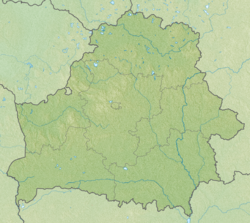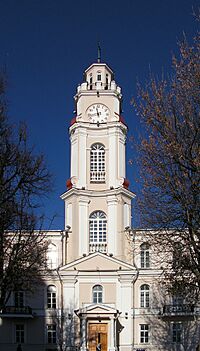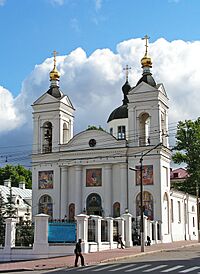Vitebsk facts for kids
Quick facts for kids
Vitebsk
Vitsyebsk
|
|||
|---|---|---|---|
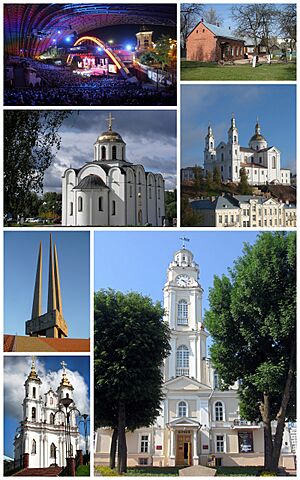
Left: Vitebsk Slavianski Bazaar, Vitebsk Annunciation Church, Pieramohi Offensive Monument in Pieramohi Square, Vitebsk Christ Resurrection Church; Right:Vitebsk Mark Chagali House, Vitebsk Assumption Cathedral, Vitebsk City Hall (all items listed from top to bottom)
|
|||
|
|||
| Country | Belarus | ||
| Region | Vitebsk Region | ||
| Founded | 974 | ||
| Area | |||
| • City | 124.54 km2 (48.09 sq mi) | ||
| Elevation | 172 m (564 ft) | ||
| Population
(2024)
|
|||
| • Urban | 358,395 | ||
| Time zone | UTC+3 (MSK) | ||
| Postal code |
210000
|
||
| Area code(s) | +375-212 | ||
| License plate | 2 | ||
| Website | Official website: http://www.vitebsk.gov.by/en | ||
Vitebsk or Vitsyebsk is a large city in northern Belarus. It is the main city of the Vitebsk Region and Vitebsk District. However, it is managed separately from the district. In 2024, about 358,395 people lived there. This makes Vitebsk the fourth-largest city in Belarus. The city has two airports: Vitebsk Vostochny Airport and Vitebsk Air Base.
Contents
History of Vitebsk
How Vitebsk Began
Vitebsk grew up around a river harbor. This is where the Vićba River flows into the larger Western Dvina. The city's name comes from the Vićba River.
Archaeologists have found signs of early settlements here. First, Baltic tribes lived at the mouth of the Vitba River. Later, in the 9th century, Slavic people from the Krivichs tribe settled there.
Early Mentions and Growth
Some old stories say that Princess Olga of Kiev founded Vitebsk in 974. However, the city is first mentioned in official records in 1021. At that time, Yaroslav the Wise of Kiev gave Vitebsk to Bryachislav Izyaslavich, who was the Prince of Polotsk.
Vitebsk was an important stop on the famous trade route from the Varangians to the Greeks. By the end of the 12th century, it became a busy center for trade. It was also the capital of its own independent area, called the Principality of Vitebsk.
Vitebsk in the Grand Duchy of Lithuania
In 1320, Vitebsk became part of the Grand Duchy of Lithuania. This happened when Princess Maria, who was from Vitebsk, married Algirdas, the Grand Duke of Lithuania. By 1351, the city had built strong stone castles. In 1410, soldiers from Vitebsk fought in the important Battle of Grunwald.
Vitebsk in the Modern Era
From 1503, Vitebsk was the capital of the Vitebsk Voivodeship. In 1569, it became part of the Polish–Lithuanian Commonwealth. In 1597, Vitebsk was given special self-governing rights, known as Magdeburg rights, and its own coat of arms. These rights were taken away in 1623 but later given back in 1641.
In 1708, during the Great Northern War, the city was almost completely destroyed by the Russians. In 1772, Vitebsk became part of the Russian Empire. Under Russian rule, the old city center was rebuilt in a new style called Neoclassical.
Vitebsk During the Napoleonic Wars
The Battle of Vitebsk took place near the city in July 1812. This was when Napoleon's army tried to fight the Russian army. The French occupied the city for over three months. Napoleon even celebrated his 43rd birthday there. However, the Russian army managed to escape with few losses.
Vitebsk Before World War II
Before World War II, Vitebsk had a large Jewish population. In 1897, about 52% of the city's people were Jewish. The famous painter Marc Chagall (1887-1985) was born in Vitebsk.
In 1919, Vitebsk was briefly part of the Socialist Soviet Republic of Byelorussia. It was then transferred to the Russian Soviet Federative Socialist Republic. In 1924, it became part of the Byelorussian Soviet Socialist Republic.
Vitebsk During World War II
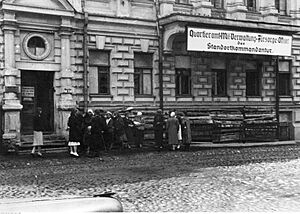
During World War II, German forces occupied Vitebsk from July 1941 to June 1944. Many Jewish people from Vitebsk were able to leave the city and find safety. However, most of the remaining local Jewish people died in the Vitebsk Ghetto in October 1941.
Much of the old city was destroyed during battles between the Germans and the Red Army. The Germans also ran a prison camp for soldiers and forced labor camps in the city. Soviet forces took back the city in June 1944.
Vitebsk After World War II
After the war, Vitebsk was rebuilt. New factories were built for machinery and tools. In 1959, a TV tower was built, and television programs began broadcasting.
Vitebsk in Independent Belarus
In January 1991, Vitebsk held its first Marc Chagall Festival. A monument to Chagall was put up on his home street in June 1992.
Since 1992, Vitebsk has hosted the annual Slavianski Bazaar. This is a big international music festival. Artists from Russia, Belarus, and Ukraine are the main performers, along with guests from many other countries. The city has seen many improvements and new buildings. The main stadium, the Summer Amphitheatre, and the railway station were all rebuilt. New churches and public buildings were also constructed.
Places to See in Vitebsk
Vitebsk has some very old buildings. One of the oldest is the Annunciation Church. It was first built in the 1140s as a pagan church. Over time, it was rebuilt as a Roman Catholic Church. It was destroyed in 1961 but was restored in 1992 to look like its original design.
Other churches from the Polish-Lithuanian period were also destroyed. However, the Resurrection Church (built 1772–77) has been rebuilt. The Orthodox cathedral, called the Intercession of the Theotokos, was built in 1760.
Other important buildings include:
- The Town Hall (built in 1775).
- The Russian governor's palace, where Napoleon celebrated his birthday in 1812.
- The Neo-Romanesque Roman Catholic cathedral (built 1884–85).
- An obelisk that remembers 100 years since Russia's victory over Napoleon.
Vitebsk also has a tall steel TV tower. It is 245 meters (804 feet) high and was finished in 1983. You can also visit the Marc Chagall Museum and the Vitebsk regional museum.
Vitebsk's Climate and Weather
Vitebsk has a climate with warm summers and cold winters. This type of climate is called a humid continental climate. Summers are generally warm. Winters are cold, but not as cold as in Moscow. This is because warm air from the Baltic Sea affects Vitebsk more. The city gets about 724 millimeters (28.5 inches) of rain each year.
| Climate data for Vitebsk (1991–2020, extremes 1886–present) | |||||||||||||
|---|---|---|---|---|---|---|---|---|---|---|---|---|---|
| Month | Jan | Feb | Mar | Apr | May | Jun | Jul | Aug | Sep | Oct | Nov | Dec | Year |
| Record high °C (°F) | 10.4 (50.7) |
10.9 (51.6) |
23.1 (73.6) |
28.5 (83.3) |
32.5 (90.5) |
35.4 (95.7) |
34.7 (94.5) |
37.8 (100.0) |
30.1 (86.2) |
24.6 (76.3) |
14.9 (58.8) |
10.7 (51.3) |
37.8 (100.0) |
| Mean daily maximum °C (°F) | −2.7 (27.1) |
−1.8 (28.8) |
3.7 (38.7) |
12.0 (53.6) |
18.7 (65.7) |
22.2 (72.0) |
24.2 (75.6) |
23.1 (73.6) |
17.1 (62.8) |
9.7 (49.5) |
2.7 (36.9) |
−1.3 (29.7) |
10.6 (51.1) |
| Daily mean °C (°F) | −5.0 (23.0) |
−4.7 (23.5) |
0.0 (32.0) |
7.2 (45.0) |
13.3 (55.9) |
17.0 (62.6) |
19.0 (66.2) |
17.7 (63.9) |
12.3 (54.1) |
6.3 (43.3) |
0.7 (33.3) |
−3.2 (26.2) |
6.7 (44.1) |
| Mean daily minimum °C (°F) | −7.2 (19.0) |
−7.4 (18.7) |
−3.3 (26.1) |
2.7 (36.9) |
8.1 (46.6) |
12.1 (53.8) |
14.2 (57.6) |
13.0 (55.4) |
8.3 (46.9) |
3.6 (38.5) |
−1.2 (29.8) |
−5.2 (22.6) |
3.1 (37.6) |
| Record low °C (°F) | −40.6 (−41.1) |
−38.4 (−37.1) |
−29.7 (−21.5) |
−17.5 (0.5) |
−4.4 (24.1) |
−1.6 (29.1) |
3.8 (38.8) |
0.2 (32.4) |
−4.9 (23.2) |
−15.0 (5.0) |
−24.0 (−11.2) |
−34.6 (−30.3) |
−40.6 (−41.1) |
| Average precipitation mm (inches) | 57 (2.2) |
49 (1.9) |
44 (1.7) |
39 (1.5) |
63 (2.5) |
76 (3.0) |
93 (3.7) |
77 (3.0) |
63 (2.5) |
67 (2.6) |
59 (2.3) |
57 (2.2) |
744 (29.3) |
| Average extreme snow depth cm (inches) | 15 (5.9) |
19 (7.5) |
14 (5.5) |
0 (0) |
0 (0) |
0 (0) |
0 (0) |
0 (0) |
0.2 (0.1) |
3 (1.2) |
13 (5.1) |
22 (8.7) |
19 (7.5) |
| Average rainy days | 8 | 6 | 9 | 13 | 16 | 17 | 17 | 14 | 16 | 17 | 14 | 10 | 157 |
| Average snowy days | 23 | 21 | 14 | 4 | 0.3 | 0 | 0 | 0 | 0.2 | 3 | 13 | 22 | 101 |
| Average relative humidity (%) | 85 | 81 | 76 | 67 | 66 | 72 | 73 | 75 | 80 | 83 | 87 | 87 | 78 |
| Source: Pogoda.ru.net | |||||||||||||
Education in Vitebsk
Vitebsk has several important universities. These include:
- Vitebsk State Technological University
- Vitebsk State Medical University
- Vitebsk State University, which is named after Pyotr Masherov.
Sports in Vitebsk
The local professional hockey team is HK Vitebsk. They play in the Belarusian Extraleague.
Vitebsk's Twin Cities
Vitebsk is twinned with many cities around the world. This means they have special friendly relationships.
The city was also previously twinned with:
 Zielona Góra, Poland
Zielona Góra, Poland Frankfurt an der Oder, Germany
Frankfurt an der Oder, Germany Panevėžys, Lithuania
Panevėžys, Lithuania
Famous People from Vitebsk
Many notable people were born in or lived in Vitebsk. Here are a few:
- Zhores Alferov (1930–2019), a physicist who won the Nobel Prize for Physics in 2000.
- S. Ansky (1863–1920), a playwright known for The Dybbuk.
- Marc Chagall (1887–1985), a world-famous artist.
- Tanya Dziahileva (born 1991), a model.
- El Lissitzky (1890–1941), an artist.
- Aliaksei Protas (born 2001), an ice hockey player.
- Kazimierz Siemienowicz (1600–1651), an engineer who helped develop rocketry.
Artistic Tributes to Vitebsk
In 1928, the American composer Aaron Copland wrote a piano trio called Vitebsk: Study on a Jewish Theme. This music was inspired by a Jewish folk song from S. Ansky's play The Dybbuk. Copland named his piece after the Vitebsk region, where Ansky was born and first heard the tune.
Images for kids
See also
 In Spanish: Vítebsk para niños
In Spanish: Vítebsk para niños




